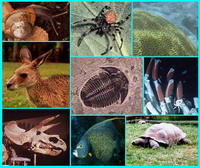Login form
Animals
 Animals live everywhere. They roam the land. They burrow in the ground. They swim in the sea. They fly through the air. They creep, they leap, they soar, and they dive. A very few—including corals and barnacles—stay in one place.
Animals live everywhere. They roam the land. They burrow in the ground. They swim in the sea. They fly through the air. They creep, they leap, they soar, and they dive. A very few—including corals and barnacles—stay in one place.
Animals come in all sizes. The biggest animals are whales, which can be 100 feet (30 meters) long. The smallest animals can only be seen through a microscope.
Zoologists (scientists who study animals) have found more than 2 million species (kinds) of animals. They think they have discovered only a small portion of all animals on Earth.
Several things make animals different from other living things. Unlike plants, animals cannot make their own food. Animals eat other living things—plants and other animals—to get energy. Animal bodies are made up of more than one cell, unlike bacteria and other life forms with only one cell. Cells are the building blocks of living things. Animals also have senses, such as eyes or ears, that tell them what is going on around them.
WHAT KINDS OF ANIMALS ARE THERE?
Zoologists divide animals into about 30 groups. First, they divide them by whether they have a backbone. Animals that have a backbone are called vertebrates. Animals that do not have a backbone are called invertebrates.
The biggest and best-known animals are vertebrates. Mammals, birds, reptiles, amphibians, and fish are vertebrates. You are a vertebrate. Your backbone is also called your spine. There are about 40,000 species of vertebrates.
There are far more species of invertebrates. Even though you can probably think of many vertebrates, the many kinds of invertebrates greatly outnumber vertebrates. Almost all invertebrates are small animals. Insects, spiders, mollusks, and worms are all invertebrates. The biggest invertebrate is the giant squid. It can be up to 60 feet (18 meters) long.
COLD-BLOODED AND WARM-BLOODED ANIMALS
Zoologists divide vertebrates into two types, cold-blooded and warm-blooded animals. The body of a cold-blooded animal is the same temperature as the air or water around it. A cold-blooded animal has to stay in the sun to get warm. It must find shade to cool off. Reptiles, amphibians, and fish are cold-blooded.
The body of a warm-blooded animal stays about the same temperature all the time. Warm-blooded animals use food energy to stay warm. Some warm-blooded animals can sweat to cool off. Birds and mammals are warm-blooded.
You are warm-blooded. The normal temperature of your body stays at about 98.6° Fahrenheit (37.0° Celsius). When it is hot outside, you feel hot. You might sweat or look for an air-conditioned place. But your body temperature does not change. When it is cold outside, you feel cold. You might put on a coat or go indoors. But your body temperature does not change much.
PLANT EATERS AND MEAT EATERS
All animals eat plants, other animals, or the remains of dead animals. Animals that only eat plants are called herbivores. They eat seeds, nuts, grasses, stems, or flowers. Some mammals, such as cows, are plant eaters. Some insects, such as termites, only eat plants. Bees, moths, and butterflies suck nectar from flowers.
Animals that only eat meat are called carnivores. The meat can be from other living animals or animals that have died. Many meat eaters hunt the animals that they eat. Sharks go after smaller fish. Lions and wolves hunt deer and other mammals. Owls swoop down on rabbits, squirrels, rats, and mice. Some frogs and lizards zap insects with their sticky tongues. Hyenas and vultures mainly eat animals that are already dead.
Animals that commonly eat both animals and plants are called omnivores. Bears and opossums are omnivores. Humans are omnivores. They eat fruit, vegetables, fish, chicken, and steak.
HOW ANIMALS BREATHE
All animals must breathe oxygen to stay alive. They must breathe out a waste gas called carbon dioxide.
Some animals breathe through lungs. Lungs take oxygen out of air. Cattle, dogs, cats, whales, people, and other mammals breathe through lungs. Birds and reptiles also breathe air through lungs.
Lungs cannot take air from water. Seals, whales, dolphins, and other mammals that live in water breathe through lungs. They can stay underwater a long time because they can hold their breath for a long time.
Sharks and other fish breathe through gills. Gills take oxygen out of water. Snails, slugs, clams, squids, octopuses, and other mollusks breathe through gills. Crabs, crayfishes, lobsters, and shrimp have gills. Gills cannot take oxygen out of air.
Some animals breathe through their skin. Insects have small holes in their bodies called spiracles. Air comes in through the holes. Oxygen from the air goes through tubes to all parts of an insect’s body.
Amphibians, animals that live on land and in water, can also breathe through their skin. Amphibians also may have lungs or gills or both.
Source: Microsoft ® Encarta

